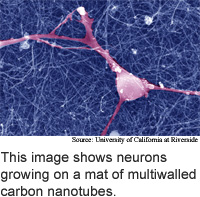
Nanotubes boost neuron growth
Researchers from the University of California
at Riverside have coaxed neurons from a rat's brain to grow on a mat of
multiwalled carbon nanotubes.
The method is a step toward neuron-electronic interfaces that
would allow for direct biological control of computers and prosthetic
devices.
Carbon nanotubes are rolled-up sheets of carbon atoms that are
a natural ingredient of soot, can be smaller than one nanometer in diameter,
and have useful electrical properties. Multiwalled carbon nanotubes consist
of a group of nested tubes.
The researchers produced nanotubes of positive, neutral and negative
surface charge by attaching different molecules to the ends of the tubes.
They coaxed neurons taken from a rat hippocampus to grow on the carbon
nanotubes and measured the growth and branching of the neurons' arms,
or neurites.
They found that the surface charge of nanotubes can be used to
control the outgrowth of neurons. Positively-charged nanotubes turned
out to be better substrates than neutral or negatively-charged nanotubes.
The neurons grew for a week, which shows that long-term integration of
nanotubes and nerve cells is possible, according to the researchers.
The researchers are working on linking neurons to silicon devices
using carbon nanotubes as intermediaries.
Practical neuron-silicon interfaces for computers and prosthetics
are 10 to 20 years away, according to the researchers. The work appeared
in the March 10, 2004 issue of Nano Letters.
Software fuse shorts bugs
Holograms enable pocket projectors
Memory cards make connections
Interface blends screen and video
Briefs:
Paper promises better e-paper
Birds-eye view helps guide public
Nanotubes boost neuron growth
Chip protects single atoms
Mega video enables virtual window
Method tests molecular devices

Research Watch blog
View from the High Ground Q&A
How It Works
RSS Feeds:
News
Ad links:
Buy an ad link
Ad links: Clear History
Buy an ad link
|
TRN
Newswire and Headline Feeds for Web sites
|
© Copyright Technology Research News, LLC 2000-2010. All rights reserved.